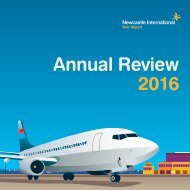Airport Masterplan 2035 LOW RES
You also want an ePaper? Increase the reach of your titles
YUMPU automatically turns print PDFs into web optimized ePapers that Google loves.
<strong>Masterplan</strong> <strong>2035</strong><br />
Air Traffic<br />
10.46 The assessment of aircraft movements has shown<br />
that there would be an increase in NOx emissions of<br />
approximately 60% by <strong>2035</strong> compared to 2015, which<br />
aligns with the increase in air traffic movements and<br />
passengers. However, future emissions from aircraft<br />
are unlikely to result in exceedances of pollutant levels<br />
within areas of prolonged public exposure. There is also<br />
anticipated to be a decrease in the tonnes of NOx per<br />
passenger in the future, due to the use of newer aircraft<br />
with improvements in fuel flow and emissions, and larger<br />
passenger capacity aircraft. Figure 35 shows the forecast<br />
reduction in NOx levels per million passengers per annum<br />
to <strong>2035</strong>.<br />
Mitigation measures<br />
10.47 The <strong>Airport</strong>’s Air Quality Strategy contains a number of<br />
policies with the overall aim to improve air quality, which<br />
will be continued going forward. This strategy will be<br />
reviewed during the <strong>Masterplan</strong> period when new initiatives<br />
will be considered.<br />
10.48 The following actions are will be continued or implemented<br />
over the <strong>Masterplan</strong> period;<br />
l Maintain a programme of spot sampling across the<br />
<strong>Airport</strong> site and extend the study area to include local<br />
villages and areas which are sensitive to air pollution;<br />
l Assess the potential to install permanent continuous air<br />
quality monitors on the <strong>Airport</strong> site;<br />
l Review the types of vehicles used on site and their<br />
impact on air quality, potentially moving to an electric<br />
operational vehicle fleet.<br />
l Encourage the use of more sustainable surface access<br />
modes, as set out in the Surface Access Strategy.<br />
l Minimise emissions from Auxiliary Power Units (APU)<br />
for aircraft while on the ground by using Fixed Electrical<br />
Ground Power (FEGP) at stands if available.<br />
l Establish an information and education programme for<br />
airport staff, relevant operators and the general public,<br />
with the aim of informing them of the issues concerning<br />
air pollution<br />
l Continue to work with Sustainable Aviation to<br />
encourage the industry as a whole to reduce air quality<br />
emissions.<br />
Figure 35 – Tonnes of NOx per million passengers per annum over the <strong>Masterplan</strong> Period<br />
60<br />
50<br />
NOx (tonnes) per mppa<br />
40<br />
30<br />
20<br />
10<br />
0<br />
2017 2025 2030 <strong>2035</strong><br />
Year<br />
78<br />
79




